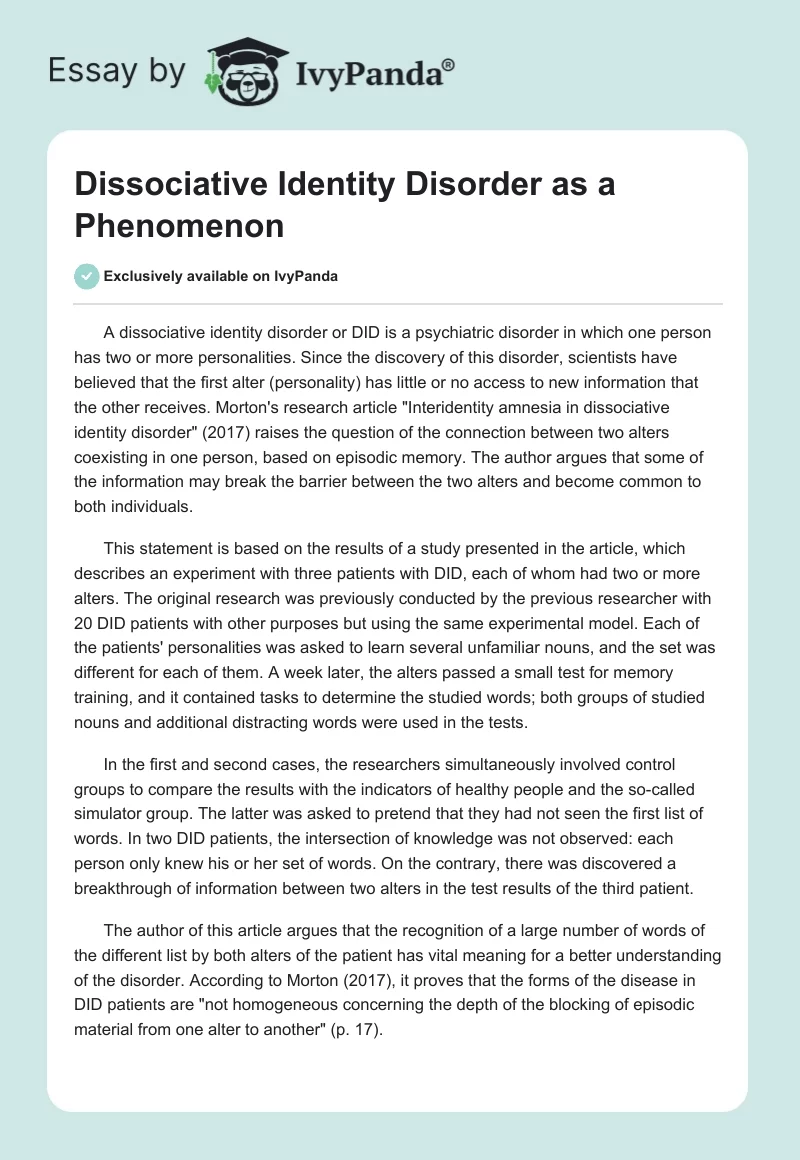A dissociative identity disorder or DID is a psychiatric disorder in which one person has two or more personalities. Since the discovery of this disorder, scientists have believed that the first alter (personality) has little or no access to new information that the other receives. Morton’s research article “Interidentity amnesia in dissociative identity disorder” (2017) raises the question of the connection between two alters coexisting in one person, based on episodic memory. The author argues that some of the information may break the barrier between the two alters and become common to both individuals.
This statement is based on the results of a study presented in the article, which describes an experiment with three patients with DID, each of whom had two or more alters. The original research was previously conducted by the previous researcher with 20 DID patients with other purposes but using the same experimental model. Each of the patients’ personalities was asked to learn several unfamiliar nouns, and the set was different for each of them. A week later, the alters passed a small test for memory training, and it contained tasks to determine the studied words; both groups of studied nouns and additional distracting words were used in the tests.
In the first and second cases, the researchers simultaneously involved control groups to compare the results with the indicators of healthy people and the so-called simulator group. The latter was asked to pretend that they had not seen the first list of words. In two DID patients, the intersection of knowledge was not observed: each person only knew his or her set of words. On the contrary, there was discovered a breakthrough of information between two alters in the test results of the third patient.
The author of this article argues that the recognition of a large number of words of the different list by both alters of the patient has vital meaning for a better understanding of the disorder. According to Morton (2017), it proves that the forms of the disease in DID patients are “not homogeneous concerning the depth of the blocking of episodic material from one alter to another” (p. 17).
Morton also discusses the nature of dissociative identity disorder, raising the question of the relationship of the disorder with the patient’s psychological or physical trauma. Citing different opinions of colleagues, the researcher notes that inner identity amnesia is most often associated with the subconscious desire of a person to displace traumatic memories, pass them to someone else.
Dissociative amnesia is an acute memory disorder in which a person forgets personal information associated with severe destructive stress, but retains other types of memories. The degree of memory impairment can vary – from minor gaps to the complete loss of memories of events that occurred during a certain period (Ashraf et al., 2016). Amnesia is a protective mechanism, an attempt to protect the psyche from unbearable loads (Brand et al., 2016).
The cause of memory disorders can be any severe psychological stress. Amnesia with obvious clinical symptoms usually develops when the patient enters the conditions that pose a direct threat to life. It can be natural disasters (floods, earthquakes), fires, industrial disasters, staying in a war zone, or criminal incidents. It can also occur in the background of physical, psychological, emotional, and sexual violence in the family.
However, the peculiarity of dissociative identity disorder is that it encourages scientists to call different phases of the patient’s behavior different personalities. All the alters have their character, thinking, memory, which is also consistently preserved and transmitted from episode to episode, as well as the characteristics of the main personality (Ashraf et al., 2016). This is the critical difference between dissociative identity disorder and usual amnesia.
It seems most likely that dissociative disorder is presumably caused by the combined effects of external and internal factors. It might be severe stress, the predisposition of some people to dissociation, or the implementation of the psychological defense mechanism in the process of living organism development. The researcher believes that the formation of a unified identity occurs in the process of human development, which means that self-determination in humans is not innate (Morton, 2017). If the child’s development is affected by some traumatic factors, the process of integration of a unified personality is disrupted, and dissociative disorder occurs.
This study and its subsequent discussion in Morton’s paper opens up new horizons for scientists who study DID as a phenomenon that demonstrates the lack of knowledge about the human mind. Morton’s conclusion that personalities in one body can not only influence one another but also unconsciously transmit the information received seems to be fair and shows that the barrier separating the alters is not as strong as it seemed. Of course, the study has some limitations, such as a relatively small number of DID patients participated. However, the precedent demonstrates a deep connection between the personalities of DID patients. The results of this study can be used to improve the diagnosis and treatment of DID in the future, as well as to influence the revision of the classical understanding of this disorder.
References
Ashraf, A., Krishnan, R., Wudneh, E., Acharya, A., & Tohid, H. (2016). Dissociative identity disorder: A pathophysiological phenomenon. Journal of Cell Science and Therapy, 7(251), 1-3.
Brand, B. L., Vissia, E. M., Chalavi, S., Nijenhuis, E. R. S., Webermann, A. R., Draijer, N., & Reinders, A. A. T. S. (2016). DID is trauma based: Further evidence supporting the trauma model of DID. Acta Psychiatrica Scandinavica, 134(6), 560-563.
Morton, J. (2017). Interidentity amnesia in dissociative identity disorder. Cognitive Neuropsychiatry, 22(4), 315-330.


